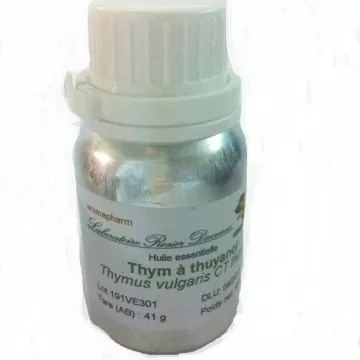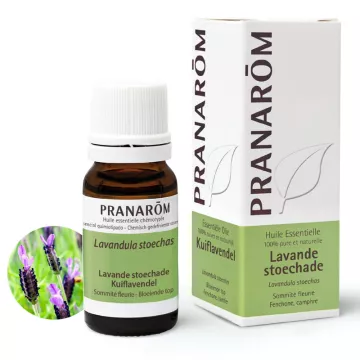Because precision makes all the difference in aromatherapy, Soin-et-Nature offers you a selection ofessential oils chemotyped HECT and EOBBD. These are rigorously controlled extracts, chosen for their quality, traceability and therapeutic efficacy. Each oil is unique, derived from an identified plant, harvested under the right conditions, and distilled to preserve its integrity. Whether you're looking to soothe pain, strengthen your defenses or simply find a better balance, these essential oils offer you a natural, safe solution tailored to your needs.
More details

The chemotype of an E.O. is defined by the level of the molecule most present in the E.O..
For example,thyme E.O. contains 50% thymol, which defines its chemotype. A molecule is generally only included in an E.H. if it exceeds 10%. All E.H.s whose percentage of molecules is not mentioned are present only in trace amounts.
The chemotype used in aromatherapy makes it possible to identify chemical variations in secondary metabolites within the same species, due to environmental factors (altitude, sunshine, temperature, humidity, etc.). This means that the essence produced by two plants of the same species, despite their very similar genotype and morphology, may vary greatly in chemical composition. This is a very important concept in aromatherapy.
An essence can be extracted from any organ as long as it has the structures to produce it. Many E.H.s come from flowers, leaves, seeds, fruits, rhizomes and so on. The same plant from the same biotope (living environment characterized by a certain number of characteristics such as temperature, humidity, etc.) can synthesize essences with very different compositions and odors, depending on the producing organ in question. The best-known example is the bitter orange tree, from which 3 distinct E.O.s can be extracted. The leaves givepetit grain bigarade E.O., the flowers giveneroli E.O., while the fruit rind gives bitter orange zest essence.
The plant from which the raw material is extracted can be cultivated or harvested in the wild. The conditions of cultivation, harvesting, drying, storage, etc. determine the quality of the plant and therefore that of the essence produced. If the plant is obtained by cultivation, it must, at the very least, be ecologically sound, and therefore do without chemicals (pesticides, weedkillers, etc.) likely to pollute the soil. The plant must also grow in its natural biotope, or one very close to it.
There are various methods for extracting the essence produced by aromatic plants. Of these, the European Pharmacopoeia selects only three to obtain a product that can be called an essential oil:steam distillation, dry distillation for stems and barks in a suitable apparatus, or a suitable mechanical process without heating for citrus fruits.
Other techniques: There are other methods for extracting essences, but the product obtained cannot be defined as an essential oil.
Unlike vegetable oils, E.O.s are volatile, which means they can be extracted with steam. With rare exceptions (cinnamon bark, cloves), their density is lower than that of water. They are immiscible in aqueous media, but soluble in the usual organic solvents. E.H.s are also active under polarized light, a property used to control their quality. The rotatory power of an E.H. also makes it possible to identify pure, natural oils. Finally, their refractive index " n " is high. Of varying degrees of color, the entire spectrum is represented: from the blood-red of certain savories, to the blue of Chamomilla recutita, to the pale green of Citrus bergamia. You can even observe the ultraviolet of mandarin orange under a UV lamp.
E.H.s are complex substances, and may contain :
However, composition can vary greatly depending on the plant producing the essence, its geographical origin, climate, altitude, extraction method, the skill of the handler, etc.
Soin-et-Nature offers a complete range of essential oils to meet many health and well-being needs. Here are the categories available:
These essential oils available on Soin-et-Nature allow you to take advantage of the benefits of plants to treat everyday ailments naturally, while favouring a gentle and effective approach.